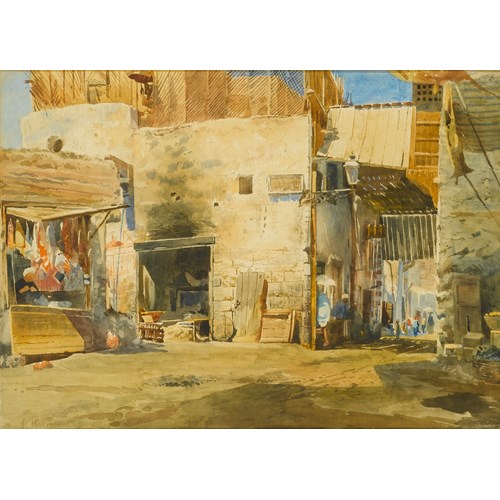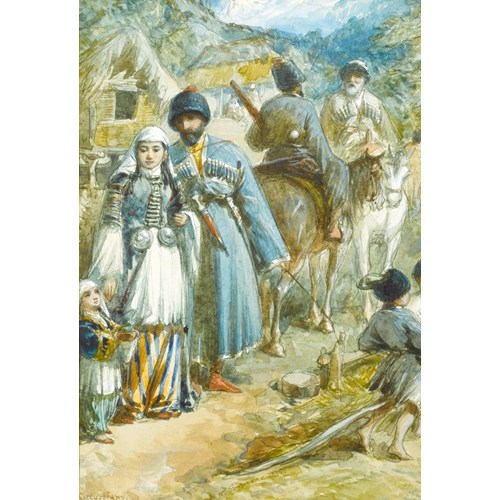Marketplace
A Russian Merchant Brig in Rough Seas
Grigorij Ivanovich Kapustin
A Russian Merchant Brig in Rough Seas
Epoque 1850-1900, 19th century, 20th century
Origine Ukraine
Medium Watercolour, Bodycolour on paper
Dimension 11.4 x 15.8 cm (4¹/₂ x 6¹/₄ inches)
In this small and beautiful watercolour, Grigorij Kapustin has depicted a solitary ship making its way through choppy seas at dusk. The work exhibits a controlled harmony of blues, greys and whites, and this restrained palette is enlivened by the orange streak of the setting sun, and the two splashes of red, as the flags atop the ship’s masts are buffeted about by the wind. In the foreground, Kapustin has painted in detail the surging waters: the tonal range in this section, from the white froth to the dark navy-blue, captures the depth and shifting nature of the sea. In contrast to this animated foreground, the ship appears to be almost static; its sails are furled and there is no sign of human activity. This, coupled with a feeling of isolation, creates a sense of tranquillity in the work, despite the rough seas.
A Russian Merchant Brig in Rough Seas is typical of Kapustin’s work. Around the turn of the twentieth century, he lived and worked in Odessa, in Southern Ukraine. The city was a significant Black Sea port and trade with merchant ships, like the one depicted in the present work, was integral to its economic life. Odessa was the fourth largest in nineteenth-century imperial Russia, and, with the sea so linked to the city’s success, it is natural that seascapes, similar to Russian Merchant Brig in Rough Seas, should make up such a large part of Kapustin’s work.
A Russian Merchant Brig in Rough Seas is comparable to much of the work of another artist, famous for his seascapes, who also spent considerable time working in Odessa and for whom the beauty of the Black Sea was also a considerable influence, Ivan Konstantinovich Aivazovsky . Aivazovsky’s Ships on a Rough Sea, Sunrise, for example, shares many of the qualities of the present work. Kapustin in fact attended Aivazovsky’s art school in Feodosija and seems to have worked closely with him for a while; the elder artist’s influence is clear in a comparison of their works. Both pictures capture the sense of growing turbulence in the water. The choppy nature of the swelling sea is a feature of both foregrounds, and dark horizons suggest an inevitable worsening of the weather. In both works, the vessels are dwarfed by the vast expanses of sea and sky, which stretch away into the distance, creating a sense of isolation. Both artists have chosen to depict times of day when the orange and pink hues of the sun create soft light effects and contrast with the variety of blues that make up the greater part of the paintings. Although Kapustin’s seascapes are often less dramatic than Aivazovsky’s, they share many of the same themes, stylistic traits and motifs.
Unfortunately Kapustin’s life is not well documented. After attending Aivazovsky’s school it seems he spent much of his working life in Odessa. Despite his inclination to depict the sea he does not seem to have had a nautical background, but his love of nature is reflected in the fact that his other favoured subjects were isolated forest landscapes, inspired by the thick wooded mountains of the Crimea. His work, although heavily influenced by Aivazovsky, is less dramatic, more restrained and accurate in its depictions of nature.
A Russian Merchant Brig in Rough Seas is typical of Kapustin’s work. Around the turn of the twentieth century, he lived and worked in Odessa, in Southern Ukraine. The city was a significant Black Sea port and trade with merchant ships, like the one depicted in the present work, was integral to its economic life. Odessa was the fourth largest in nineteenth-century imperial Russia, and, with the sea so linked to the city’s success, it is natural that seascapes, similar to Russian Merchant Brig in Rough Seas, should make up such a large part of Kapustin’s work.
A Russian Merchant Brig in Rough Seas is comparable to much of the work of another artist, famous for his seascapes, who also spent considerable time working in Odessa and for whom the beauty of the Black Sea was also a considerable influence, Ivan Konstantinovich Aivazovsky . Aivazovsky’s Ships on a Rough Sea, Sunrise, for example, shares many of the qualities of the present work. Kapustin in fact attended Aivazovsky’s art school in Feodosija and seems to have worked closely with him for a while; the elder artist’s influence is clear in a comparison of their works. Both pictures capture the sense of growing turbulence in the water. The choppy nature of the swelling sea is a feature of both foregrounds, and dark horizons suggest an inevitable worsening of the weather. In both works, the vessels are dwarfed by the vast expanses of sea and sky, which stretch away into the distance, creating a sense of isolation. Both artists have chosen to depict times of day when the orange and pink hues of the sun create soft light effects and contrast with the variety of blues that make up the greater part of the paintings. Although Kapustin’s seascapes are often less dramatic than Aivazovsky’s, they share many of the same themes, stylistic traits and motifs.
Unfortunately Kapustin’s life is not well documented. After attending Aivazovsky’s school it seems he spent much of his working life in Odessa. Despite his inclination to depict the sea he does not seem to have had a nautical background, but his love of nature is reflected in the fact that his other favoured subjects were isolated forest landscapes, inspired by the thick wooded mountains of the Crimea. His work, although heavily influenced by Aivazovsky, is less dramatic, more restrained and accurate in its depictions of nature.
Epoque: 1850-1900, 19th century, 20th century
Origine: Ukraine
Medium: Watercolour, Bodycolour on paper
Signature: Signed in Cyrillic (lower right)
Dimension: 11.4 x 15.8 cm (4¹/₂ x 6¹/₄ inches)
Plus d'œuvres d'art de la Galerie







 A Woman Bending forwards in Work, and_T638856835938571470.jpg?width=500&height=500&mode=pad&scale=both&qlt=90&format=jpg)

